All-Ceramic Crown: Shouldered Abutment
Page 1 | Page 2 | Page 3 | Page 4 | Page 5 | Page 6
Acrylic Sleeve Selection
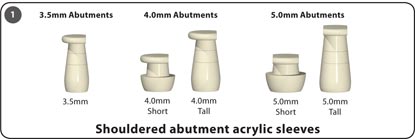 |
|
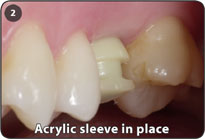 |
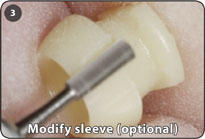 |
1. Choose a tall or short acrylic sleeve depending upon the anatomy of the interdental papillae. The sleeve should support the papillae without encroaching upon them, while helping to maintain a soft tissue sulcus. Snap the sleeve onto the seated stealth shouldered abutment. The external and internal flats of the acrylic sleeves are designed to align the sleeve with the corresponding flats on the abutment.
2. The tall or short acrylic sleeve will help form and maintain a soft tissue sulcus.
3. The acrylic sleeve may be modified to achieve a desired clinical situation.
Notes: The acrylic sleeve may be used for: making an abutment level transfer impression, fabricating a transitional crown, recording an occlusal registration, or as an abutment corrective coping.
Each 4.0 and 5.0mm stealth shouldered abutment is packaged with two corresponding acrylic sleeves.
Indirect Abutment Transfer / Temporization
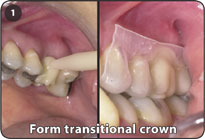 |
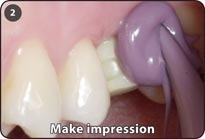 |
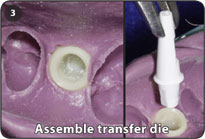 |
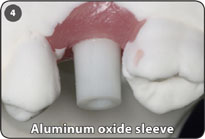 |
1. Inject temporary crown material (e.g., Integrity™ by Dentsply) around the acrylic sleeve to form a transitional crown with or without a vacuum formed template.
2. After the transitional crown has been made, snap another tall or short acrylic sleeve onto the shouldered abutment for the making of an indirect abutment transfer impression. The use of the tall or short acrylic sleeve as an impression coping will accurately record the margin of the abutment for an all-ceramic crown.
3. After the acrylic sleeve has been withdrawn in the impression, insert a polycarbonate abutment transfer die into the acrylic sleeve in the impression for the pouring of a soft tissue and stone dental model. Confirm the orientation of the corresponding flats and confirm that there is no gap between the acrylic sleeve and the shoulder of the abutment transfer die.
4. Send the impression and/or model to the laboratory for the fabrication of an all-ceramic crown with Bicon’s aluminum oxide sleeve which acts as the core for the all-ceramic crown.
Notes: The 3.5mm stealth shouldered abutment should only be used with an implant level transfer impression and the extra-oral crown cementation technique.
Keys to Success
- To facilitate confirmation of complete seating of an all-ceramic crown, it is advisable to use the technique for making an implant level impression and for extra orally cementing a crown.